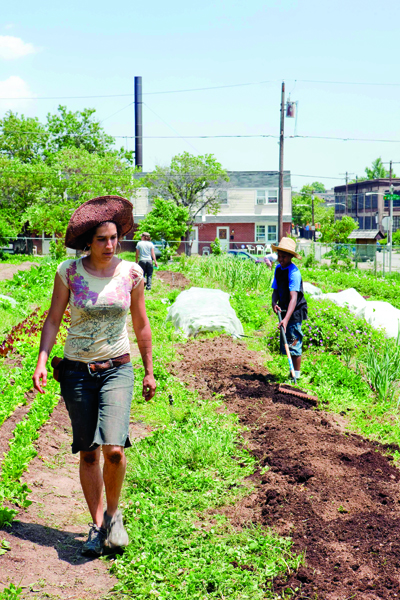 Mill Creek Farm sets a standard for sustainable farming
Mill Creek Farm sets a standard for sustainable farming
by Will Dean
Bat Cave #2. That’s the first thing you can easily make out about the main farm building at West Philly’s nonprofit Mill Creek Farm. It’s painted in yellow on a piece of metal that juts out of a low, glimmering building in the middle of a green plot at 49th and Brown. Though no bats yet live in the cave—actually a small structure meant to mimic the attics the nocturnal animals prefer—the attempt to attract them is just one example of the creativity and ingenuity on display at Mill Creek.
“We want them because they eat mosquitoes,” says Johanna Rosen, one of the two women who run Mill Creek. Their choice to attract bats instead of spraying chemicals is one of Mill Creek’s goals: to grow healthy, fresh and chemical-free food to support their community.
“[T]here’s no place to buy healthy produce; there’s a real lack of access in the city,” says Jade Walker, the other woman behind Mill Creek. “The Philadelphia Food Charter [a declaration released by the city in October ’08] says they want everyone to be able to access healthy food within 10 minutes of their homes, and they have so far to go in that respect. There’s corner stores, there’s Chinese shops, there’s pizza shops, but there’s no place to go to buy healthy produce. That is a really significant problem, particularly in low-income neighborhoods.”
To help fix that, Mill Creek offers produce for sale at the farm on Saturdays from 11 a.m.-2 p.m. and on Thursdays at the bus stop on 52nd and Haverford from 1 p.m.-5 p.m., donates food twice a week to community food shelters and sells produce at the Mariposa Food Co-Op on Baltimore Ave. They start the produce stands in late June to get their food sales to coincide with a state payment—an extra 20 dollars as part of food stamps—to purchase local food.
Despite their small size—their plot is about half as long as the block and as wide as a few rowhomes—Mill Creek produces a variety of veggies. Leeks, spinach, collards, carrots, beets, cilantro, dill, cucumbers, lettuce, chard, kale, tomatoes, potatoes, peppers, okra, sweet potatoes, asparagus, strawberries, beans, sunflowers, turnips and mustard greens all pop out of the soil. They were already harvesting asparagus in early May and getting local favorites planted.
“People come to the table and ask, ‘Where are the collard greens, where is the okra, where are the sweet potatoes?’ ” Rosen laughs. “Our first year we had one row of okra, the next year we had two and this year we’ll have three or four rows. We can’t keep up with demand.”
Their commitment isn’t just about providing food, since their plot can only produce so much, but education and advocating around food access. When they applied for the land in 2005, they were both working for the Urban Nutrition Intiative, teaching nutrition and gardening. “We were doing a lot of food systems education,” says Walker, “and it became really clear that there was this major disconnect between the tomato you buy from the store and any concept of where it comes from and how it’s grown.”
So they started Mill Creek to both teach people about growing food in an urban setting and how to do it as sustainably as possible.
Almost everything used at the farm comes from the land, or salvage. The main building itself is made using “cob,” a construction method that uses dirt, sand, straw, water and other objects (in their case bottles, bike parts and tiles) to make an adobe-like structure.
Rosen and Walker showed me around the farm and the many improvements they’ve worked on since getting access to the land as part of a Water Department project to decrease water runoff into the sewer system.
If everything looks handmade, that’s because it usually is. The farm was a vacant lot before, “just trash and weeds,” according to Rosen, but now it sparkles with life. A mural inside the building is made from tiles plucked from a dumpster and some mirrors a friend didn’t need. The pastiche of colorful tile pieces and mirror shards are reminiscent of the stuff local artist Isaiah Zagar has covered the South Street area with, but it depicts the silhouettes of the six high school students who helped build the farm from nothing in 2006.
Rosen points to some bathtubs and piping: “This mess is part of a project we’re working on with some students from the University of the Arts. They’re in an industrial design class and they’re helping us design a graywater system. We want to route the water through these tubs and some water barrels, and have different tanks to get the sediment out, and have plants in there to clean out the water.” She motions up at the building’s overhang, which is actually made of solar panels. “With these solar panels, we’re going to run a pump to get clean water for hand-watering.”
Next to the panels, there’s a living roof, made from compost and expanded slate, spotted with a variety of sedum, a succulent that usually grows in the mountains. The plants have expanded a lot in the past few years and they hope the plants will continue to spread. “If everyone had green roofs in the city,” says Rosen, “we would have a lot less stormwater runoff and urban heat island effect.”
Slow drip irrigation delivers the water to the plant’s roots—so less is lost to evaporation—feeding the fields when it doesn’t rain. Beehives made from stacked wooden boxes with frames of comb inside produce honey and pollinate crops.There’s even a composting toilet, and, of course, a tool shed with farming implements volunteers can use. Walker says, “[We want to be] an education space to learn about where vegetables come from and how they’re grown. We’ve had over 2,000 volunteers in the past year.”
Mill Creek is also trying to make sure the green space they’ve carved out of the urban landscape remains preserved. Presently, the land is owned by the Redevelopment Authority, a department of the city that manages city-owned property. The Water Department manages the Mill Creek plot and leases it to Rosen and Walker as a stormwater retention project.
While it succeeds at reducing stormwater runoff—thanks to the absorbant soil, water-hungry plants and a berm installed by the Water Department—Mill Creek is much more, and the farmers of Mill Creek don’t want to lose it. They’re trying to get the space donated to a land trust run by the Neighborhood Garden Association that would guarantee it remains green space.
“It’s really important to protect the farm and the community garden as open space for growing food and education and these continued environmental benefits for the neighborhood,” says Rosen.
The only hurdle remaining is approval from City Councilwoman Jannie Blackwell, who represents this section of West Philly. All of the other city authorities have agreed to the deal, so the two women have been circulating a petition, and urge people to contact Blackwell on their website.
Regardless of how long it takes to get the land set aside, Walker and Rosen are committed to continuing their work at Mill Creek.
“For me right now, the largest conundrum is if you want to grow food in the city, sell it here and live off it,” says Walker, gesturing to the rows of new crop
s rising out of the soil. “Why do you have to only be supporting very high-end markets in Rittenhouse Square, or somewhere like that, and make your food cost a lot and only service a very, very small percentage of the population that is of a particular privilege? There are all these macro pictures and this micro answer to some of them here.”




